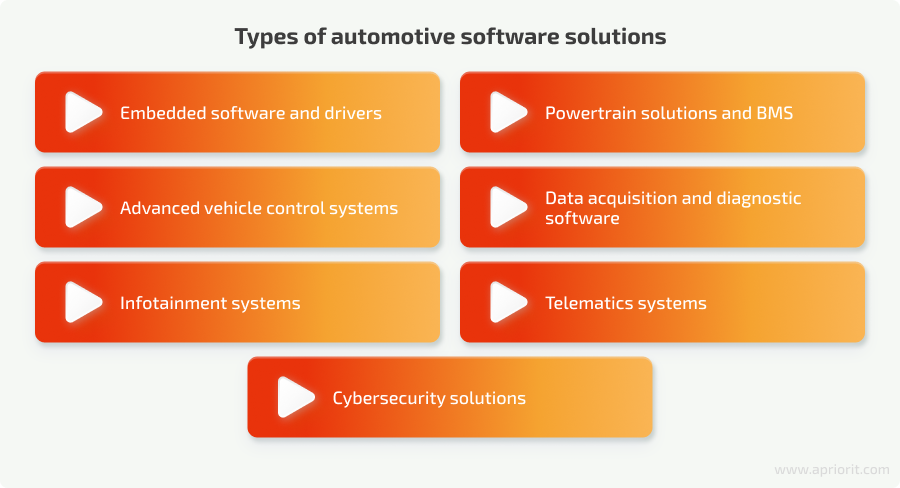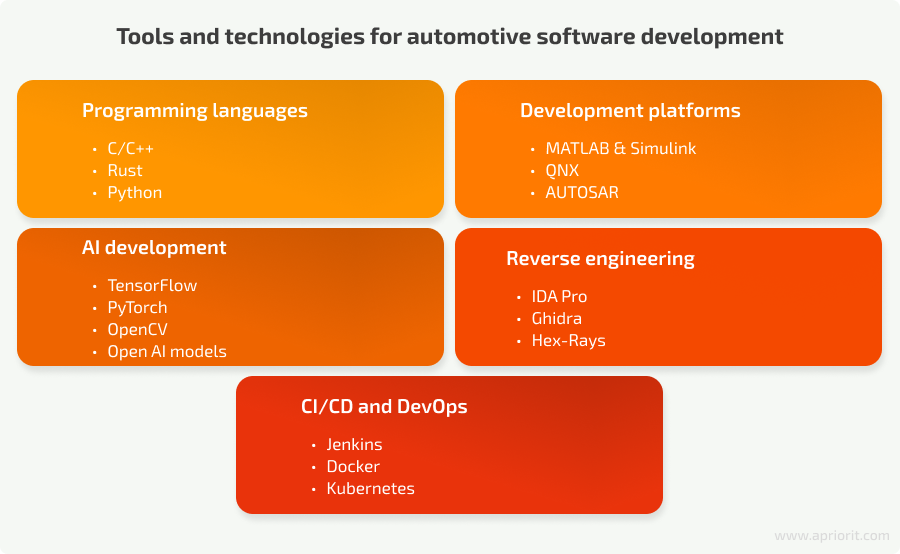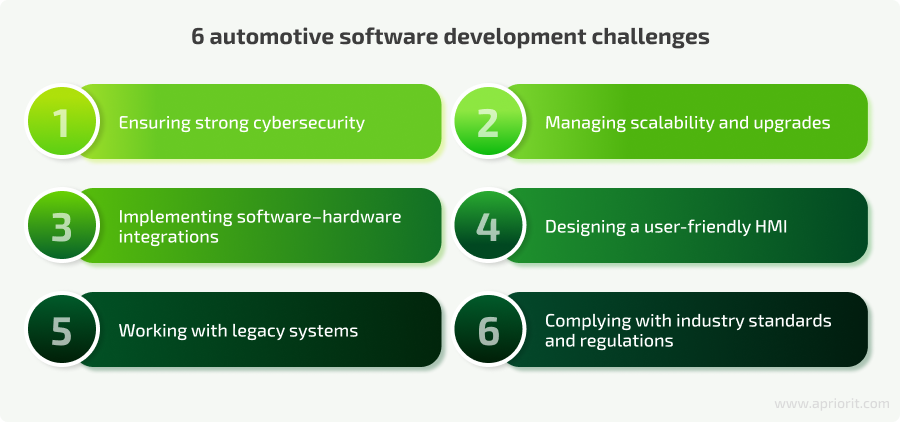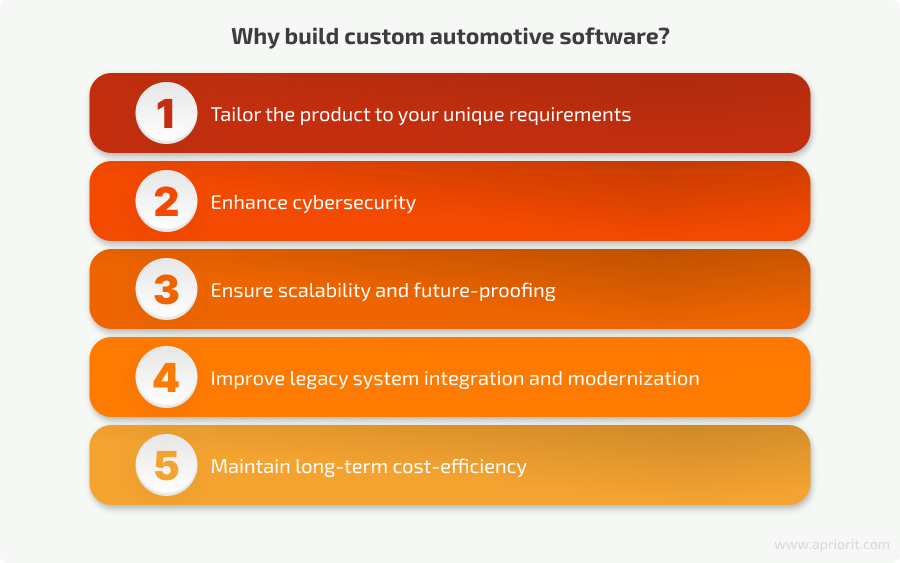Modern automotive software is designed to solve various tasks, from managing small sensors for driver assistance to making real-time decisions for autonomous driving. This diversity of tasks means that as an original equipment manufacturer (OEM) or automotive software vendor, you’ll need to make sure that your products are highly secure, well-performing, and tailored to ever-changing market demands.
In this article, we discuss relevant automotive software development trends and analyze what challenges to expect and how to address them when aiming to deliver a high-quality custom automotive software solution. We also overview key aspects of automotive software development to help you grasp the nuances of this process.
This article will be helpful to OEMs and automotive software vendors who want to understand the impact of custom automotive software development on solving key industry challenges and want to build or enhance their own smart, connected, and autonomous vehicle systems.
What is automotive software development?
Automotive software development is the process of creating dedicated applications and systems for modern vehicles. Depending on its format, such software can manage one or several essential vehicle-controlling functions, including:
- Battery or powertrain management
- Vehicle-to-everything (V2X) communication
- Infotainment
- Driver assistance
- Autonomous driving
To deliver secure and efficient automotive software, you’ll need a team of experienced software engineers with a solid understanding of vehicle mechanics, relevant technology trends, and cybersecurity specifics. And as modern smart vehicles can be targeted by cybercriminals, incorporating the principles of a secure software development lifecycle (SDLC) is crucial for strengthening your product against possible cyber attacks.
Need expert assistance with building or enhancing your automotive software?
Delegate your most challenging software engineering tasks to Apriorit!
Common types of automotive software solutions
We can outline several key categories of automotive software solutions, each of which is responsible for managing specific vehicle functions:

Embedded software and drivers are responsible for core vehicle functions like engine control, sensor integration, and infotainment. Embedded solutions enable real-time communication between a vehicle’s hardware and software components, ensuring their seamless operation.
Powertrain solutions and battery management software (BMS) optimize fuel consumption in traditional cars and manage battery life and performance in electric vehicles (EVs). Such solutions monitor the powertrain or battery health to improve performance and prevent issues like overheating and overcharging.
Related project
Developing Software for a Drone Battery Charging and Data Management Unit
Discover the Apriorit approach to transforming drone management with mobile and embedded solutions that boost data reliability and control efficiency.
Advanced vehicle control systems integrate advanced driver assistance systems (ADAS) and autonomous driving technologies. These systems process sensor data in real time to assist or replace human drivers, supporting Level 2 to Level 5 autonomy. Features such as adaptive cruise control and collision avoidance enhance safety, while AI and machine learning power autonomous capabilities.
Infotainment systems provide navigation, entertainment, and connectivity for both drivers and passengers. These systems can integrate with external devices like smartphones and tablets as well as services like media streaming and voice assistants.
Data acquisition and diagnostic software collects vehicle performance data from various components, while diagnostic software analyzes this data to detect faults and inefficiencies. Together, they power predictive maintenance capabilities and help to detect and prevent vehicle failures in a timely manner.
Telematics systems enable real-time communication between vehicles and external systems, supporting remote diagnostics, fleet management, and predictive maintenance. Telematics are essential for connected vehicles and V2X communication.
Cybersecurity solutions for connected vehicles secure sensitive data and critical operations in connected vehicles, protecting them against cyberattacks. These solutions commonly include intrusion detection systems, encryption technologies, and real-time monitoring solutions.
Now that we’ve explored key types of automotive software, let’s discuss trends that can impact the way you approach building such software.
Read also
Artificial Intelligence in the Automotive Industry: 6 Key Applications for a Competitive Advantage
Uncover how AI is transforming the automotive industry. Discover key AI applications in the automotive sector and get practical insights for integrating AI into your automotive solutions.
5 key trends in automotive software development
New technological advancements and changes in customer preferences have a direct impact on the evolution of automotive software development trends. The more effectively you choose and incorporate these trends to meet your customers’ needs, the higher your chances to outrun the competition and rule the market.
Let’s take a look at some of the most important technological solutions your development team should keep an eye on:

Electrification — EFESO forecasts that by 2030, every second car sold in Europe will be fully electric. As the shift toward EVs accelerates, the need for advanced powertrain and battery management software is also growing. Efficient battery management software helps to maximize vehicle range and monitor battery health, while technologies like AI-powered predictive maintenance enable early detection and timely resolution of potential issues.
While Tesla may be one of the most famous electric car brands, automotive giants like BMW, Hyundai, and Volvo have their own electric vehicles.
Connectivity — Electric or not, modern vehicles can interact with their environment differently than cars manufactured a decade or two ago. With the growing shift to software-defined vehicles (SDVs), software is becoming the core element defining car functionality.
Various technologies enable efficient car connectivity. Telematics and IoT systems are essential for supporting real-time data exchange, remote diagnostics, and fleet management, creating a fully connected automotive ecosystem. V2X communication and telematics enable the real-time data exchange, over-the-air (OTA) updates, and remote diagnostics necessary for smarter traffic management and improved safety.
Autonomy — Autonomous driving software is advancing rapidly, particularly in Level 3+ autonomy. Leveraging three types of electronic vision — radar, cameras, and laser-based Lidar systems — along with ongoing AI improvements, self-driving vehicles are becoming more reliable and efficient, pushing the boundaries of full autonomy.
Some of the most well-known companies developing self-driving cars include Waymo, Kodiak Robotics, and Gatik. However, this technology still has room for improvement, specifically in terms of driving safety. Most autonomous systems still require human oversight and have limited applications.
Advanced personalization — The incorporation of voice control capabilities and AI-powered personal assistants enables hands-free interactions, reducing driver distraction and enhancing convenience.
Modern infotainment systems also offer advanced personalization capabilities for passengers, with onboard entertainment and real-time access to information.
Cybersecurity — With greater connectivity comes a greater need for robust cybersecurity measures, especially with the growing adoption of smart vehicles and advanced infotainment solutions.
The main focus of the development community is on ensuring proper security for these systems to prevent incidents that could lead to car theft, unauthorized data extraction, or unauthorized control over critical vehicle functions.
Tools and technologies for automotive software development
Depending on the task at hand, developers leverage various automotive software development tools and technologies, from general programming languages to advanced reverse engineering frameworks. Below, we briefly cover some of the most commonly used ones:

Let’s look closer at each of these categories.
Programming languages
While the choice of programming languages is nearly limitless, the most commonly used languages for writing automotive software include:
- C/C++ — Essential for building embedded systems that control engine functions, braking systems, and infotainment platforms. These languages ensure high performance and real-time execution.
- Rust — Increasingly used for safety-critical applications due to its focus on memory safety and concurrency, making it suitable for autonomous vehicle controls.
- Python — Widely used for AI development and data analytics, especially in autonomous driving and ADAS systems where real-time data processing is critical.
Development platforms
Standardized platforms and frameworks make it easier to quickly deliver quality automotive products. The list of tools that your development team may find helpful includes:
- MATLAB & Simulink — Popular for model-based design and simulation. These tools enable engineers to simulate vehicle components such as powertrains and braking systems before deployment, ensuring reliability and performance.
- QNX — A real-time operating system used in mission-critical systems such as ADAS and infotainment.
- AUTOSAR & Adaptive AUTOSAR — Frameworks that provide scalability and interoperability for real-time control software, ensuring seamless communication among vehicle components.
AI development
AI models play a crucial part in different automotive tasks, from building a predictive maintenance system to implementing advanced driver assistance. Tools that will help your team build a secure and efficient AI model include:
- TensorFlow and PyTorch — Widely used for building AI-driven models for autonomous driving and sensor fusion.
- OpenCV — A critical library for developing computer vision systems, enabling vehicles to process visual data and make decisions.
- Open AI models — Can be customized and fine-tuned for specific automotive applications, speeding up the development process and saving your budget.
Reverse engineering
From ensuring compatibility with poorly documented third-party solutions to maintaining legacy products with no documentation and fixing critical security issues, reverse engineering is irreplaceable when it comes to building a secure and well-performing software product. Tools your team can use for reversing include:
- IDA Pro and Ghidra — Popular reverse engineering tools that are commonly used to analyze legacy systems and ensure compatibility with modern software.
- Hex-Rays — An IDA decompiler for working with compiled code, enabling updates or modifications to older vehicle software.
CI/CD and DevOps
Leveraging CI/CD pipelines helps manage the complexity of testing and deploying software across various vehicle systems. Here are some of the tools your team can use for these tasks:
- Jenkins — Automates build and test processes, ensuring that updates integrate smoothly into existing vehicle systems.
- Docker and Kubernetes — Containerization tools for managing large-scale deployments, ensuring consistent software behavior across platforms.
With so many tools to use and so many tasks to tackle, the process of building automotive software can become tricky. Let’s go over the main challenges your development team is likely to face when building automotive software solutions.
Read also
Developing Custom SaaS Solutions for Transportation and Logistics
Maximize logistics efficiency with a tailored SaaS product. See how implementing a custom SaaS solution can optimize your logistics processes and drive smarter decision-making.
Challenges in automotive software development
Automotive software vendors face various challenges, from ensuring the cybersecurity of connected systems to scaling software updates across millions of vehicles. Below, we analyze the main pitfalls that automotive software developers must be prepared for.

1. Ensuring strong cybersecurity
Cybercriminals commonly target connected vehicles and those enhanced with autonomous or even advanced UX functions. Malicious actors can leverage vulnerabilities in software code to send commands from an unauthorized account or compromise in-car payments, which are threats that both Visa and Mastercard are trying to mitigate.
Attackers may target sensor data, autonomous driving algorithms, or connected vehicle platforms, potentially leading to data breaches or, worse, endangering passenger safety. Therefore, ensuring robust cybersecurity should be the top priority for automotive software developers.
To improve the cybersecurity posture of your automotive software product, consider encrypting all sensitive data and critical transactions, implementing real-time security monitoring and intrusion detection mechanisms to protect software-enhanced vehicles from external threats. OTA updates will also be necessary for deploying the latest security patches and fixing vulnerabilities quickly enough.
2. Managing scalability and upgrades
As software becomes central to vehicle functionality, it’s important to synchronize software updates across millions of vehicles worldwide. Automotive software developers must ensure seamless updates across a wide range of Electronic Control Units, sensors, and communication systems within each vehicle.
OTA updates can help manufacturers patch security vulnerabilities, fix bugs, and roll out new features remotely. However, managing all these updates at scale and in real time also presents significant challenges, from software fragmentation and performance issues to the emergence of new security gaps.
To address these challenges, it’s important to plan and implement an effective management system that will help manufacturers organize and simplify the scaling of these updates.
3. Integrating software and hardware
Automotive software must seamlessly integrate with a variety of sensors, actuators, and embedded systems while also addressing the limitations of the underlying hardware. Unlike consumer software, which can often run on general-purpose hardware, automotive software interacts directly with the vehicle’s physical components.
This integration is particularly challenging because the software must handle both the real-time constraints of safety-critical functions and extensive variability in hardware specifications across vehicle models.
Thus, automotive software developers need to ensure that their software is adaptable, resilient, and optimized for the hardware it controls, particularly for powertrains, ADAS, and battery management systems.
4. Designing a user-friendly HMI
Another significant challenge is creating a human–machine interface (HMI) that is both intuitive and responsive. With the increasing complexity of in-vehicle technologies such as infotainment systems, voice control, and head-up displays, it is critical that the user experience is seamless and non-intrusive.
That’s why your development team should design an HMI that provides drivers with easy access to essential functions without causing distraction. Balancing functionality, safety, and user experience is essential for creating a successful automotive HMI.
5. Working with legacy systems
Many automakers continue to rely on legacy systems for core vehicle functions. Upgrading or integrating new software into these older systems is a complex task that requires careful reverse engineering and development work to ensure compatibility, security, and seamless performance.
Developers also often face challenges in migrating legacy software to modern platforms while maintaining the stability of older systems. For instance, your development team may have to work with outdated documentation, analyze legacy architectures, or ensure compatibility of new software and existing hardware.
To tackle these challenges, you may need to enhance your development team with additional reverse engineering expertise.
6. Complying with industry standards and regulations
There are several regulations and standards that your team will need to account for during the development process:
- ISO 26262 governs the functional safety of road vehicles
- ISO/SAE 21434 focuses on cybersecurity requirements for vehicles
- AUTOSAR helps standardize software architectures across the industry
Depending on the data that a specific solution processes, development teams may also need to account for the requirements of data protection regulations and standards, including the GDPR or the CCPA for personal data and PCI DSS for payment data.
It’s also important to ensure that your software not only complies with these requirements but is flexible enough to adapt to the evolving regulatory landscape. Not to mention that non-compliance can lead to legal consequences, product recalls, or compromised safety.
Read also
Guide to Building GDPR-Compliant Software: 5 Software Development and Testing Tips
Simplify GDPR compliance for your product. Learn how to integrate privacy features into your apps from the get-go with Apriorit experts’ insights into building GDPR-compliant software.
Benefits of developing custom automotive software
One way to effectively tackle the challenges we discussed above is by building a custom automotive solution. This approach offers significant advantages for automotive software vendors and manufacturers

1. Tailor the product to your unique requirements — With custom development, you can design features that are fully optimized for the architecture of a specific vehicle, enhancing everything from ADAS performance to HMI usability. This results in better user experiences, improved operational efficiency, and increased reliability.
2. Enhance cybersecurity — A custom solution allows you to implement advanced, vehicle-specific cybersecurity measures right from the start. By addressing potential vulnerabilities early in the development process, custom solutions can provide more robust protection against threats targeting connected vehicles, autonomous systems, and V2X communication.
3. Ensure scalability and future-proofing — Custom automotive software is built with scalability in mind. Whether you’re deploying software across a vehicle fleet or managing multiple ECUs within a single vehicle, custom solutions provide the flexibility needed to scale efficiently. Custom development also allows you to integrate OTA update capabilities, ensuring that your software can evolve with new features and security patches long after a vehicle leaves the factory.
4. Improve legacy system integration and modernization — Custom development allows you to create bridge solutions that facilitate the integration of legacy components with new technologies, extending the useful life of your existing hardware while introducing new capabilities.
5. Maintain long-term cost-efficiency — Custom software can be designed to optimize vehicle performance, reduce the need for frequent updates, and streamline maintenance processes, reducing long-term operating costs.
In addition, custom solutions reduce the likelihood of integration issues, which can be costly to resolve, and provide better long-term support for modern and future vehicle architectures.
For companies seeking tailored solutions to meet these challenges, Apriorit offers industry-leading expertise in building custom automotive software.
Read also
AI in Auto Insurance: Possibilities, Challenges, Implementation Tips
Boost risk assessment with AI innovations. Find out how AI can empower insurers with predictive analytics, enhancing decision-making and reducing risk in car insurance.
How Apriorit can help you with automotive software development
Being a TISAX-certified software development company, we understand the nuances of the automotive software development process and can present you with solutions that will help you overcome the industry’s toughest challenges:
- Cybersecurity expertise — We build robust security systems tailored to your vehicle’s architecture, protecting against threats targeting connected vehicles and autonomous driving systems. We can also assist you with testing the security of your automotive solutions.
- Custom driver and embedded software development — Our team develops reliable, high-performance software for embedded systems, powertrain management, ADAS, and HMI interfaces, ensuring your vehicles operate smoothly and efficiently.
- Reverse engineering and legacy system support — We specialize in reverse engineering and updating legacy systems, helping you extend the life of older vehicle models while integrating modern software features.
- AI and autonomous driving development — Our expertise in AI development allows us to build machine learning models for autonomous driving and ADAS, helping you stay ahead in the race toward Level 3+ autonomy.
With Apriorit, you can form a well-balanced team consisting of experienced software engineers, quality assurance specialists, project managers, business analysts, and designers who will work exclusively on your project or enhance your existing in-house team with niche expertise.
Conclusion
Automotive software development is essential for OEMs and vendors creating smart, connected, and autonomous vehicles. Yet when building automotive software, vendors need to ensure cybersecurity, integrate software with complex hardware, and manage real-time updates across millions of vehicles.
Custom software development for automotive helps overcome these issues by delivering tailored solutions that enhance security, optimize performance, and implement scalable, future-proof architectures. Combined with a secure SDLC, this approach ensures that automotive systems are efficient, adaptable to evolving technologies, and highly protected.
At Apriorit, we specialize in delivering high-performance software solutions for niche industries. From cybersecurity to AI-powered systems and legacy system modernization, our expert team will help you create secure, scalable, and innovative automotive software tailored to your unique needs.
Need a custom application for your business?
Partner with Apriroit to design and develop high-quality applications tailored to your business goals and technical requirements.


